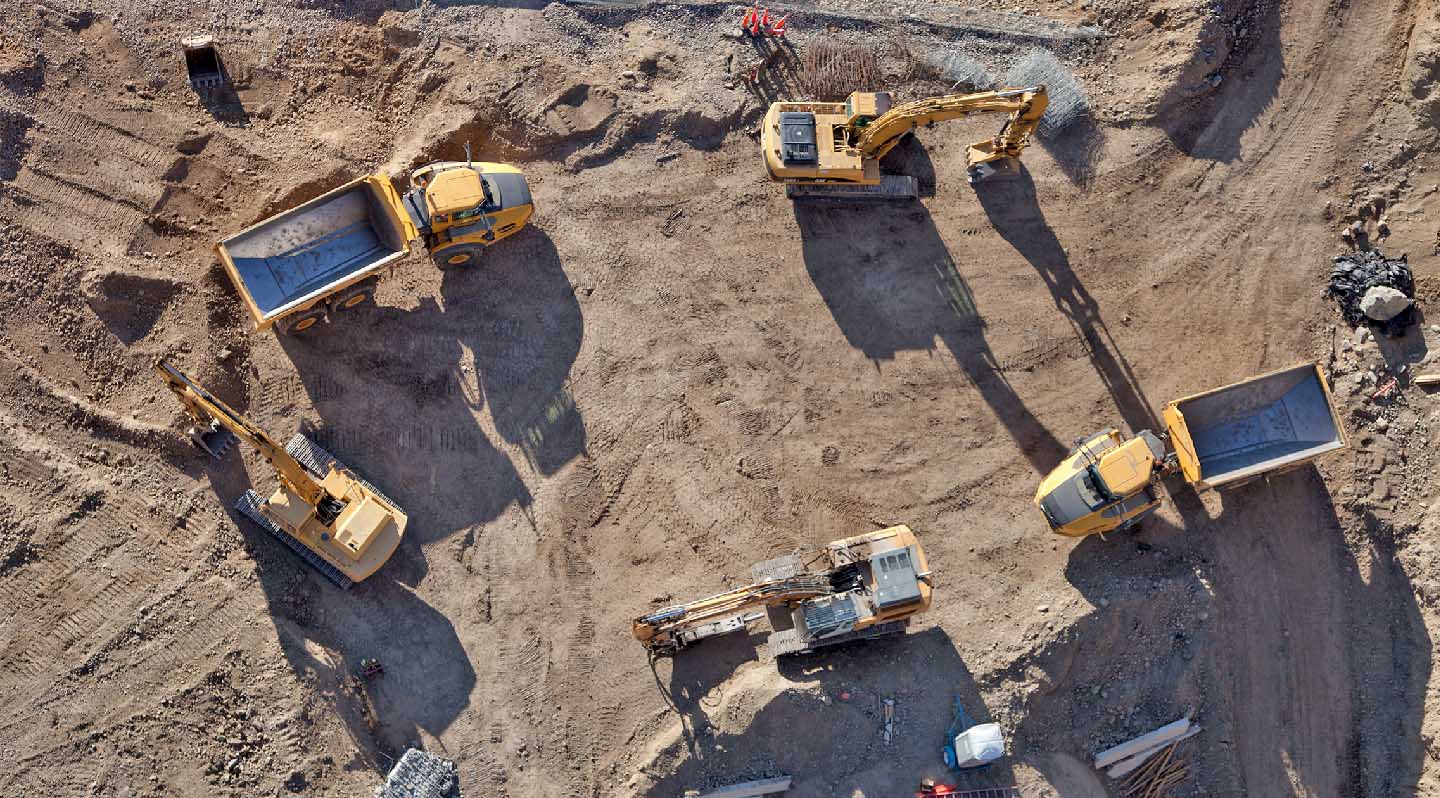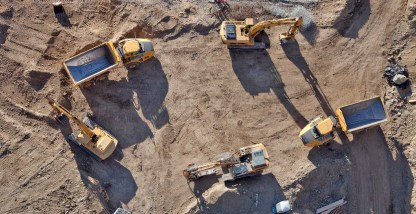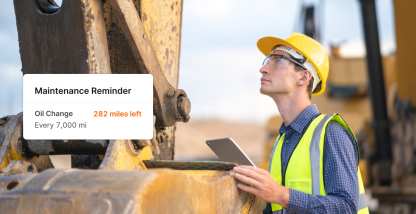Keeping your projects on schedule and on budget isn’t an easy proposition when you have limited visibility into your equipment and asset use. You may also be dealing with other time-consuming and costly distractions such as equipment thefts or spending too much time manually tracking maintenance schedules.
Why is construction fleet management important?
A construction fleet management solution helps you keep track of equipment and assets across multiple sites and yards. It can also improve the safety of your drivers and equipment operators.
When you manually track construction equipment or log maintenance schedules, it’s often prone to human error and requires more hours from fleet management. Maintenance can be overlooked and it’s easier for equipment to be misused.
With the right construction fleet management solution, you’re better able to complete jobs on time and on budget.
What are the benefits of construction fleet management software?
In this guide, we’ll explain the benefits of construction fleet management software and how one equipment management platform can provide the real-time insights you need to:
- Know at-a-glance where your drivers, assets, materials, and equipment are
- Connect vehicles, drivers, and the office so everyone can access critical information
- Optimize the use of your vehicles and assets to limit wear and tear
We’ll do this by sharing the journey of KeepBuilding in a fictional use case. To show a complete fleet management transformation in action, we’ll say that KeepBuilding is a fast-growing general contractor in Atlanta. You may identify with them. In the last year, they’ve nearly doubled its number of job sites, employees, and contractors. They’ve also increased their general workload.
With this kind of growth comes growing pains. For KeepBuilding these pains manifested in several ways:
- Locating equipment became extremely difficult.
- Overhead and job-site delays increased.
- Operational expenses quickly rose.
- Billing became more complex and time-consuming.
- Complaints about dangerous driving escalated.
If you’ve experienced one or more of the pain points above, you’ll want to continue reading. As we dive deeper into the KeepBuilding use case, we’ll also explain how construction fleet management software can help you work more efficiently.
1. Find equipment faster
Dozens of vehicles, trailers, and equipment spread across three job sites and a yard, making it difficult to locate vehicles or assets. KeepBuilding had a lot to manage. For example, locating their 70-foot-long excavator required multiple phone calls and site/yard checks. This wasted time and led to various project delays.
As their company grew, the problem just got worse. They needed to find their equipment at a moment’s notice to get their projects back on schedule.
The solution
KeepBuilding adds a GPS construction fleet tracking system that allows them to locate their vehicles, trailers, and equipment in real time.
By adding the GPS, they can now do a quick search for any vehicle or asset to view its location on a single map. This allows KeepBuilding to spend less time searching for equipment and more time using it. Taking this first step in their construction equipment fleet management program pays off immediately.
2. Provide automatic ETA updates
Construction is a business of dependencies. If one piece of equipment is missing, it can have a ripple effect on the rest of the day and possibly for days to come.
KeepBuilding experienced this firsthand, and staff found themselves spending a lot of time calling job site project managers to update them with equipment and employee ETAs.
The solution
KeepBuilding implements construction fleet management software and sets up automated ETA notifications.
Now project managers can view ETAs at any point, they also receive an alert upon arrival. This allows them to plan the day efficiently and focus on their projects.
3. Recover stolen equipment or assets
Theft accounts for losses of about $1 billion per year in the construction industry. KeepBuilding also had to manage equipment theft that cost the company valuable time, resources, and money. Losing key equipment also disrupted operations the following day and led to project delays.
The solution
With GPS tracking in place, KeepBuilding can now identify the location of missing equipment and vehicles in real time.
They’re also able to approach the problem proactively. By creating geofences around job sites and yards, they receive immediate notifications when a vehicle or asset enters or leaves a location when it shouldn’t. This allows them to intervene right away and increases the odds of recovery.
4. Take yard or job site inventory instantly
Taking inventory of equipment and vehicles is an important and regular process for KeepBuilding. As they grew and the number of job sites increased, this process quickly became time intensive and error prone.
The solution
KeepBuilding automates a good portion of its inventory process by creating a drag-and-drop geofence around each yard and job site to assist in construction fleet tracking.
With a single click, they now have a real-time list of the assets inside each geofence. KeepBuilding’s inventory process has gone from hours to seconds.
5. Bill customers faster and more accurately
KeepBuilding commonly bills customers based on the amount of time equipment is used at a job site. As they grew and they began using their equipment across more job sites, manual tracking by the hour became a bigger headache.
The solution
With job-site geofencing, KeepBuilding now racks exactly how much time any piece of equipment spends at each job site during any time period, simplifying their billing process.
6. Efficiently manage equipment and vehicle inventory
Managing the number of vehicles and other equipment needed in your construction fleet is a difficult balance. If you buy too few, you may experience project delays. If you buy too many, profit margins are basically depreciating in your yard.
Without insight into usage, purchases are made on an educated guess. It’s especially important to gain insight into real needs as a company experiences growth.
The solution
KeepBuilding is learning to manage its equipment and other assets more efficiently with fleet utilization reporting. This reporting is based on vital fleet information that’s gathered, organized, consolidated, and analyzed.
With this data, KeepBuilding can now:
- Identify the types of equipment they may have a shortage of in case of breakdowns or unexpected growth.
- Redeploy underutilized equipment to existing job sites to get projects done faster.
- Sell underutilized equipment/vehicles or lease/rent more equipment during busy seasons.
7. Monitor and reduce idle time
Between transportation and equipment usage, construction uses a lot of fuel. With their business growth, KeepBuilding’s fuel costs gradually consumed a larger percentage of revenue. They couldn’t quite pinpoint why it increased so abruptly until they saw a study outlining idling costs.
This study pointed out that some vehicles burn .8 gallons of fuel per hour. At a fuel price of $2.61, idling for just one hour per day costs $542 per vehicle annually. While there’s more variance in terms of construction equipment, the same idea holds true. Idling costs money.
The solution
When KeepBuilding adds construction fleet management software, they’re surprised to see how much time their vehicles are idling at job sites. These idling reports allow KeepBuilding to quickly identify and address excessive idling.
KeepBuilding even begins to compensate project managers who reduce idling rates, making fuel savings a financial win-win.
8. Prevent vehicle and equipment misuse
Misuse of vehicles and equipment is a common battle for construction companies like KeepBuilding whose employees take vehicles home with them. This includes using company vehicles for personal errands or side jobs.
Even if it’s just a few employees, the extra usage adds up.
The solution
To prevent misuse of company property, KeepBuilding sets up a geofence around job sites and yards to help them with their construction fleet tracking. They now receive alerts whenever vehicles or equipment move when they shouldn’t.
Once they identify a possible off-hours issue, they use the location history report to see exactly where vehicles and assets have been and when they were there.
In addition to identifying improper usage, having this capability tends to be a strong deterrent against misuse.
9. Get real-time fault code reporting and alerts
Fleet maintenance can be expensive. Experiencing a vehicle breakdown is even more expensive. This is especially true for a business like KeepBuilding. Beyond direct costs like replacement parts and mechanical labor, KeepBuilding found that indirect costs were their real problem.
As an example, let’s look at a truck that breaks down while bringing a backhoe to a job site. The delay puts excavation off until the next day. In addition, the soils engineer can’t do their open-hole inspection as planned. They don’t have availability for an additional three days. This delays the next step and the next.
The solution
While some breakdowns are inevitable, KeepBuilding significantly reduces breakdowns by taking a proactive maintenance approach.
A vehicle’s onboard diagnostic system already monitors for issues known as fault codes. KeepBuilding’s new fleet management solution captures, interprets, and displays fault codes into an easy-to-read, actionable report. This allows them to catch vehicle maintenance issues early with real-time alerts.
KeepBuilding uses this data to:
- Provide their maintenance staff and external mechanics with a complete list of vehicle defects so they can resolve every issue in a single appointment.
- Ensure vehicles with critical issues are taken off the road, preventing the issue from becoming more serious.
- Save time and money because they no longer need to run diagnostics in the shop.
10. Get mileage and time-based maintenance reminders
Equipment, vehicles, trailers, and other assets often need maintenance based on mileage, usage, and time. You can often reduce breakdowns and increase an asset’s lifespan by staying ahead of maintenance schedules.
This is often more difficult than it sounds. As KeepBuilding grew and its number of assets expanded, keeping up with its fleet’s maintenance schedules became a headache.
The solution
KeepBuilding sets up automated maintenance reminders in their construction equipment fleet management program based on mileage, usage, and time — based on each type of vehicle or asset.
With maintenance reminders and usage visibility, KeepBuilding reduces its overall equipment upkeep costs.
11. Prevent collisions
Prior to implementing a fleet management solution, the first collision occurred in one of KeepBuilding’s fleet vehicles. While nobody was injured, the event spurred management to reconsider risk.
They looked at several facts:
- The average collision costs $91,000 and $200,000 if there’s an injury.
- A single severe collision can increase insurance rates and impact a business’s ability to extend credit lines from banks.
- Dangerous driving behavior can impact your brand and sales since your fleet vehicles are a moving billboard for your business.
They knew they needed to improve safety to protect the future of KeepBuilding.
The solution
They install AI dash cams that track and coach drivers in real time when dangerous or distracted driving occurs. These AI dash cams lead to a lower insurance premium while protecting their fleet by recording their own, and other drivers, to see who’s really at fault in future collisions.
12. Identify and coach the most dangerous drivers
To prevent dangerous driving, KeepBuilding first had to identify it. They knew it had to be a top priority due to the complaints coming in.
The increase in complaints was most likely due to hiring quickly to meet demand — and hiring some more inexperienced drivers.
The solution
KeepBuilding begins to monitor the Safety Score of all of its drivers. This score is a calculation of not only dangerous driving events such as hard brakes, accelerations, and corners, but also positive driving behaviors. It also takes into account the context and severity of every safety event, assigning more weight to behaviors that are likely to lead to collisions.
With this information, KeepBuilding identifies its most dangerous drivers. They find it especially helpful to monitor new driver performance and provide coaching so their drivers learn to meet company expectations.
When a dangerous driver is identified, KeepBuilding can view the full details for each driving event along with the cause, whether it be tailgating or the driver having been cut off.
KeepBuilding can also watch the event for themselves in HD video with a single click.
KeepBuilding can then coach drivers on what to do differently in the future and track their progress with coaching statuses. Drivers can even watch their own videos from an app.
As an unexpected bonus, KeepBuilding found that reducing aggressive driving increased fuel efficiency by 20-30%.
13. Protect against litigation
Unfortunately, collisions happen. And often, it won’t be your driver’s fault. While there was no litigation in KeepBuilding’s accident, it raised the question, “If there was litigation, could we prove what happened?”
Without video evidence, for any company managing a large fleet, the answer may be no.
The solution
To limit their risk, KeepBuilding adds a dash cam. With video evidence of critical events and the ability to recall videos from the past, they’re able to defend themselves in situations where they aren’t at fault.
Why use Motive as your construction fleet management software?
While KeepBuilding is a fictional example, its problems, solutions, and results are based on real construction businesses that have used Motive to get visibility into their business, automate manual work, reduce operational costs, and prevent collisions.
If your business is facing some of the same challenges as KeepBuilding, request a demo and we’ll show you how we can help you build a better way to work.










